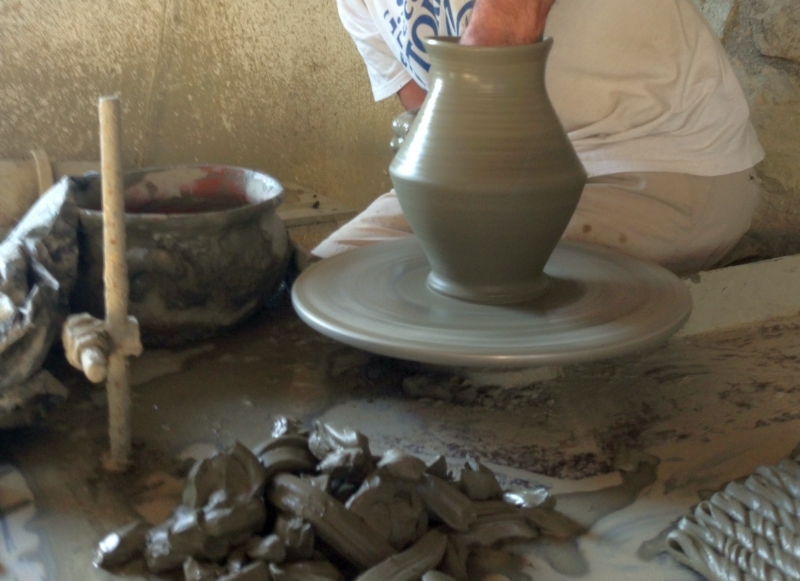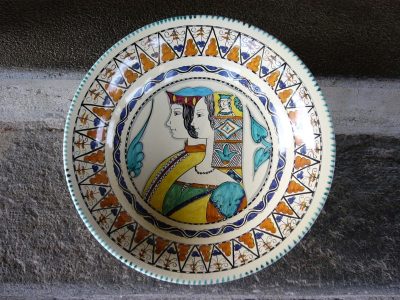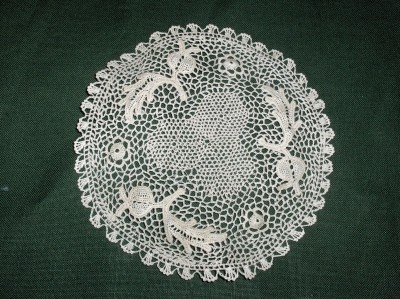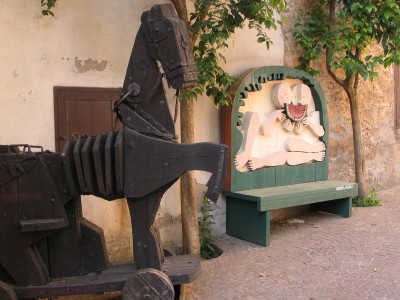
Ancient origin, current tradition
For over two millennium Orvieto crafts have gone hand in hand with the historical and sociological evolution of the city. Even before the Etruscans, in prehistoric times, this area was full of local arts. Everyday objects such as dishes, vases, statues, crowns, clothing and more.
In medieval times, the arts and crafts were organized into guilds, divided by areas of expertise. Since then, even in step with the times of modernization Orvieto has always been place of importance in Italian arts.
Orvieto Ceramics

The process of making this pottery has historically been passed from generation to generation, which prevailed in Orvieto as a major local craft acquiring its own well-defined identity. There is a medieval kiln recently discovered in the center of Orvieto, that now displays many pieces. The medieval pottery of Orvieto is noted for excellent workmanship and innovative decorations. The predominant colors were coppery green, white and black manganese, and the major themes depicted were leaves, animals and female figures. The history of ceramics in Orvieto has several historical moments passing by a great creative fervor and widely disseminated to periods of stasis. The rediscovery and re-enhancement of the ceramic must also to an illustrious Orvieto, Pericles Perali, always engaged in the study of Etruscan history of Orvieto, and that during excavations and research in the “throw” of the city recovered several finds of ancient pottery giving new impetus to the study and knowledge of Orvieto’s medieval pottery. A Perali we owe the creation of the art of Vascellari which contributed together with the artist Ilario Ciaurro, (director in 1921 of the Vascellari Orvieto factory) to the final revival of the art form. Finds and discoveries of ancient medieval and renaissance ceramics are on display at the Pozzo della Cava and at the Museum of Medieval and Renaissance Majolica of Orvieto, while pieces of Etruscan pottery are on display in the Archaeological Museum and Civico-Faina.
Orvieto Lace

Another important Orvieto art is lace making. In 1907, from the initiative of members of the local aristocracy, was born Ars Wetana, patronage society that aimed to give women an opportunity to work at home. The idea was launched by Senator Eugene Conte Faina and was made possible thanks to his son Claudio, who gave the first funds to his daughter Maria Eugenia Victoria, and noblewomen Petrangeli and Pauline Valentini. He was responsible for identifying a simple, but valuable job, that women could perform at home. He chose the Irish lace for its authenticity and because it is possible to divide the work among more than one worker.
Ars Wetana involved in the manufacturing and packaging of lace, and lace with special references to the ornamental cathedral of Orvieto. Typical decorative motifs are ornate designs of ivy leaves, acanthus, vines, flowers, figures and animals drawn from the bas reliefs of the Duomo. In the early years when it affirmed the Ars Wetana, Orvieto lace began to spread and improve beyond the company’s patronage. In fact, two significant figures, Maria Luisa Geremei Pettinelli and Luigi Moretti, worked with staff and creativity helped expand the expressive possibilities of this art to a high artistic level. (Photo work of L.Lovisa).
Woodworking in Orvieto

Another long standing traditional art of Orvieto is woodworking. There are many artisans and shops in the city dedicated to this material.
A long experience which sees the figure of Gualverio Michelangeli (1929-1986) one of the greatest artist of this craft, and founder of a genre that has been copied by many other popular woodworkers. The art of wood processing in Orvieto ranging from objects to furniture.
A symbol of this thriving city is in the alley by Michelangeli, where their works displayed capture the attention of visitors. (Photo from Bottega Michelangeli).
You can see wooden sculptures made by Michelangeli in several places around the city and in the Caffe Montanucci, one of the most famous and oldest in Orvieto.
Other Artisan Workshops
Beside ceramics, lace and wood, you will find other local artisans and specialized laboratories of other typical materials in Orvieto such as leather, terracotta, wrought iron and jewelry. In particular you can easily find in the city these local artisans and laboratories in the Via dei Magoni, also called “Via degli Artigiani”.
Visit this page: https://www.orvietoviva.com/en/orvieto-artisans/ to find out local artisans shops in Orvieto



